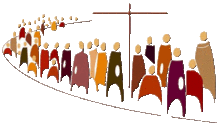Chemin Neuf Community
| Chemin Neuf Community | |
|---|---|
 | |
| Orientation | Roman Catholic |
| Polity | Hierarchical |
| Leader | François Michon |
| Region | 30 countries |
| Members | 2,000 |
| Official website | www.chemin-neuf.org.uk |
| Part of a series on the |
| Catholic Church |
|---|
 |
| Overview |
|
|
|
Controversies |
|
Links and resources
|
|
|
The Chemin Neuf Community (French: Communauté du Chemin Neuf) is a Catholic ecumenical community in which Christians from all walks of life live and work together for the Gospel, regardless of which church they attend.[1] Created from a Charismatic prayer group in 1973, it has currently around 2,000 members from all the major Christian denominations in 30 countries.[2] Its main founder was the Jesuit father Laurent Fabre.[3]
Practices
The community was named after the first meeting in Lyon, Montée du Chemin Neuf (meaning "going up the new road"). It was founded in the Charismatic Renewal and remains heavily marked by Ignatian spirituality. The community focuses its action on the principle of unity: unity of Christians, unity of men, unity of couples and families. It regularly organises retreats for couples, families and / or engaged couples ("Cana"), for divorcees ("Cana Espérance"), for divorcees who have remarried ("Cana Samarie"), an international evangelization (Net for God / Fraternité Œcuménique Internationale (FOI)), as well as an evangelization in the neighbourhood (evangelization in the street, the Alpha course), sessions for young people, theological, philosophical and artistic training, and retreats following the Spiritual Exercises of Ignatius of Loyola.
Status
The community is composed of lay and religious persons from all Christian denominations: Catholic, Anglican, Reformed, Orthodox. In 1984, it was recognised by Cardinal Alexandre Renard, and declared a Public association of the faithful by Cardinal Albert Decourtray, Archbishop of Lyon. This canonical status allowed it to teach the Christian doctrine on behalf of the Catholic Church and to promote public worship. From a civil point of view, the community was recognised as a religious congregation by a decree from the Prime Minister of France, on 23 July 1993.
In France, the community has several branches located in Lyon, Anse (Rhône),[4] Soleymieu (Isère),[5] Hautecombe (Savoie),[6] Le Plantay (Abbey Notre-Dame-des-Dombes, Ain),[7] Sablonceaux (Charente-Maritime), Tigery (Essonne), Chartres (Eure-et-Loir), Bouvines (Nord), Marseille (Bouches-du-Rhône), Levallois (Hauts-de-Seine), Paris, Villeurbanne (Rhône), Lucé-Mainvilliers (Eure-et-Loir), Lille (Nord), Reims (Marne), Sophia-Antipolis (Alpes-Maritimes), Angers (Maine-et-Loire). The community is also present in Belgium, Brazil, Burkina Faso, Burundi, Canada, Chad, Congo, Côte d'Ivoire, the Czech Republic, Egypt, Germany, Hungary, Israel, Italy, Libya, Madagascar, Martinique, Mauritius, the Netherlands, Poland, Réunion, Switzerland, and the United Kingdom.
In 2014, the Archbishop of Canterbury, Justin Welby, invited young adults from around the world to join the Community of St Anselm, a Jesus-centered community of prayer facilitated by the Chemin Neuf for one year. Ruth Gledhill of Christian Today wrote that "The year-long programme will include prayer, study, practical service and community life. Members will live a spiritual discipline compared to that of medieval monks, drawing closer to God through a daily rhythm of silence, study and prayer. At the same time they will also be immersed in the modern challenges of the global 21st century church, witnessing to the power of a pared-back disciplined faith in managing the demanding business of contemporary high-tech life.".[8]
Controversy
In the 1990s, a small number of former community members accused it of being a cult practising brainwashing and proselytism. The French anti-cult association Centre contre les manipulations mentales also included the community in its Dictionary of Cults.[9] Jérôme Dupré-Latour, a priest of the Archdiocese of Lyon, noted some cultic deviances, including strict obedience and the authoritarian exercise of power.[10] Archbishop Jean Balland,[11] Father Jean Vernette,[12] and founder Father Laurent Fabre denied these accusations.[11] None of the accusations were proved in court.[13]
See also
| Wikimedia Commons has media related to Communauté du Chemin Neuf. |
References
- ↑ "Archived copy". Archived from the original on 2013-07-03. Retrieved 2012-02-02.
- ↑ http://www.chemin-neuf.org.uk
- ↑ "La Communauté du Chemin Neuf" (in French). Conférence des évêques de France. Retrieved 2009-08-14.
- ↑ http://www.leprogres.fr/beaujolais/2015/12/07/la-vie-familiale-au-coeur-des-pothieres
- ↑ http://www.chateau-fort-manoir-chateau.eu/manoirs-isere-manoir-a-soleymieu-manoir-de-montagnieu.html
- ↑ http://www.liberation.fr/societe/2000/02/07/une-abbaye-a-la-croisee-des-chemins-theologiques-la-communaute-charismatique-de-hautecombe-recoit-de_316384
- ↑ http://www.leprogres.fr/loisirs/2012/08/08/ain-visite-de-l-abbaye-notre-dame-des-dombes-au-plantay
- ↑ Gledhill, Ruth (5 September 2014). "The young nuns: Justin Welby invites young people to live monastic life at Lambeth Palace". Christian Today. Retrieved 6 September 2014.
- ↑ Dico des sectes, Annick Drogou, Milan edition, 1998
- ↑ "Communauté du Chemin Neuf Association publique de fidèles — Appréciation des statuts reconnus par le diocèse de Lyon" (in French). Troumad. Retrieved 2009-08-14.
- 1 2 "Les charismatiques sont-ils sectaires ?" (PDF) (in French). Dernières Nouvelles d'Alsace. 1996-06-26. Retrieved 2009-08-14.
- ↑ Jean Vernette (2001-01-15). "L'Eglise catholique et les sectes" (in French). Conférence des évêques de France. Retrieved 2009-08-14.
- ↑ Thierry Baffoy, Antoine Delestre, Jean-Paul Sauzet, Les Naufragés de l'Esprit, Des sectes dans l'Église catholique, Le Seuil editions, 1996
External links
- Community of the Chemin Neuf, site officiel
- NetForGod TV, official site
- Mission Jeunes 18-30 ans, official site
